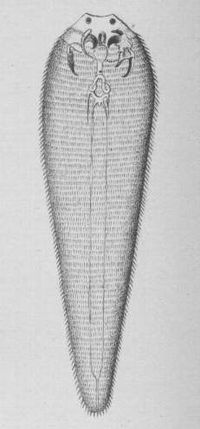
Linguatula serrata
Encyclopedia
Linguatula serrata is a cosmopolitan
zoonotic parasite, belonging to the Pentastomida
, also known as tongue worms. They are wormlike parasites of the respiratory systems of vertebrates. They live in the nasopharyngeal region of mammal
s. Cat
s, dog
s, fox
es, and other carnivores
are normal hosts of this parasite. Apparently, almost any mammal is a potential intermediate host
.
Physical characteristics: males: 18–20 mm (0.708661417322835–0.78740157480315 in) in length, while the females are 80–120 mm (3.1–4.7 in).

Cosmopolitan distribution
In biogeography, a taxon is said to have a cosmopolitan distribution if its range extends across all or most of the world in appropriate habitats. For instance, the killer whale has a cosmopolitan distribution, extending over most of the world's oceans. Other examples include humans, the lichen...
zoonotic parasite, belonging to the Pentastomida
Pentastomida
Pentastomida are an enigmatic group of parasitic invertebrates commonly known as tongue worms due to the resemblance of the species of the genus Linguatula to a vertebrate tongue....
, also known as tongue worms. They are wormlike parasites of the respiratory systems of vertebrates. They live in the nasopharyngeal region of mammal
Mammal
Mammals are members of a class of air-breathing vertebrate animals characterised by the possession of endothermy, hair, three middle ear bones, and mammary glands functional in mothers with young...
s. Cat
Cat
The cat , also known as the domestic cat or housecat to distinguish it from other felids and felines, is a small, usually furry, domesticated, carnivorous mammal that is valued by humans for its companionship and for its ability to hunt vermin and household pests...
s, dog
Dog
The domestic dog is a domesticated form of the gray wolf, a member of the Canidae family of the order Carnivora. The term is used for both feral and pet varieties. The dog may have been the first animal to be domesticated, and has been the most widely kept working, hunting, and companion animal in...
s, fox
Fox
Fox is a common name for many species of omnivorous mammals belonging to the Canidae family. Foxes are small to medium-sized canids , characterized by possessing a long narrow snout, and a bushy tail .Members of about 37 species are referred to as foxes, of which only 12 species actually belong to...
es, and other carnivores
Carnivora
The diverse order Carnivora |Latin]] carō "flesh", + vorāre "to devour") includes over 260 species of placental mammals. Its members are formally referred to as carnivorans, while the word "carnivore" can refer to any meat-eating animal...
are normal hosts of this parasite. Apparently, almost any mammal is a potential intermediate host
Intermediate host
A secondary host or intermediate host is a host that harbors the parasite only for a short transition period, during which some developmental stage is completed. For trypanosomes, the cause of sleeping sickness, humans are the primary host, while the tsetse fly is the secondary host...
.
Morphology
The adult parasite is dorsoventrally flattened, tapering backwards resembling a vertebrate tongue, originating its name from it.Physical characteristics: males: 18–20 mm (0.708661417322835–0.78740157480315 in) in length, while the females are 80–120 mm (3.1–4.7 in).
Behavior and reproduction
Both male and females are required to mate for successful reproduction. Males choose to mate with females that are close to their own size. Females contain hundreds of thousands of eggs.Epidemiology
Infection of Cairo dogs varies from male to female, with a ratio of 1.9:1 (58.97% and 30.77%, respectively). Prevalence of infection rate is higher during spring and summer (66.67%), compared during fall and winter, which constitutes 33.33% of the infection rate. The probable source of canine infections is infected lymph nodes of cattle, sheep, goats, and/or camels, which produce the symptoms of halzoun and the marrara syndrome in man when consumed raw .Geographic range
L.serrata can be found worldwide but especially in warm subtropical and temperate regions.Life cycle
Adult L. serrata embed their forebody into the nasopharyngeal mucosa, feeding on blood and fluids. Females live at least two years and produce millions of eggs. Eggs exit the host in nasal secretion or, if swallowed, with feces. When swallowed by an intermediate host, the four-legged larvae (resembling a mite) hatch in the small intestine, penetrate the intestinal wall, and lodge in tissues, particularly in lungs, liver, and lymph nodes. The nymphal stage develops. When eaten by a definitive host, infective nymphs either attach in the upper digestive tract or quickly travel there from the stomach, reaching the nasopharynx. Females begin egg production in about six months.

